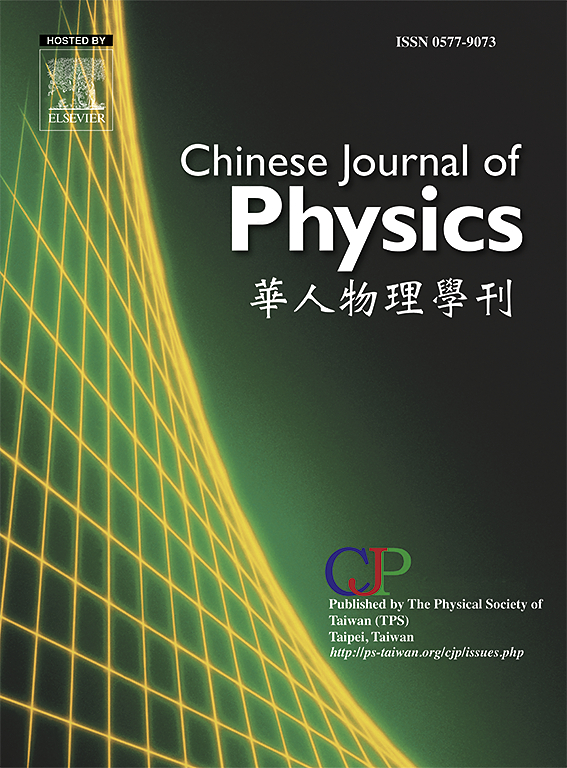二维PtSe2和PtTe2纳米片的非线性吸收特性
IF 4.6
2区 物理与天体物理
Q1 PHYSICS, MULTIDISCIPLINARY
引用次数: 0
摘要
作为过渡金属二硫族化合物(TMDCs), PtSe2和PtTe2具有很好的非线性光学(NLO)性质,但对其非线性吸收(NLA)性质缺乏系统的研究。假设PtSe2和PtTe2具有相同的六方晶体结构。在这项研究中,我们使用开放孔径(OA) z扫描技术在355,532和1064 nm波长下系统地评估了它们的NLO特性。两种材料均表现出显著的双光子吸收(TPA),其TPA截面(σTPA)随波长的减小而增大。在紫外波段(355nm),二维PtTe2的σTPA比二维PtSe2的σTPA大1个数量级左右,表现出更强的光限效应。考虑到两种材料的结构差异主要是由阴离子取代引起的,我们从能带结构的角度进一步研究了2D PtTe2优越的OL性能。这一分析阐明了自旋轨道耦合(SOC)效应引起能带分裂的潜在物理机制。该研究不仅推动了TMDCs在NLO领域的高功率激光保护,OL器件和紫外光探测方面的前景。它还为高性能NLO材料的设计和开发提供了有价值的见解。本文章由计算机程序翻译,如有差异,请以英文原文为准。

Nonlinear absorption properties of two-dimensional PtSe2 and PtTe2 nanosheets
As transition metal dichalcogenides (TMDCs), PtSe2 and PtTe2 exhibit promising nonlinear optical (NLO) properties but lack systematic studies on their nonlinear absorption (NLA) properties. Given that PtSe2 and PtTe2 possess an identical hexagonal crystal structure. In this study, we systematically evaluate their NLO properties using open-aperture (OA) Z-scan technique performed at wavelengths of 355, 532, and 1064 nm. Both materials showed significant two-photon absorption (TPA), with their TPA cross-sections (σTPA) increasing trend as decreasing wavelength. The σTPA of two-dimensional (2D) PtTe2 exhibited around one order of magnitude larger than that of 2D PtSe2 in the ultraviolet (UV) band (355 nm), particularly, indicating a stronger optical limiting (OL) effect. Considering that the structural difference between the two materials primarily arises from anion substitution, we further investigated the superior OL performance of 2D PtTe2 from the perspective of band structure. This analysis elucidates the underlying physical mechanism associated with band splitting induced by spin-orbit coupling (SOC) effects. This study not only advances TMDCs as promising candidates for high-power laser protection, OL devices, and UV photodetection in the NLO field. It also offers valuable insights for the design and development of high-performance NLO materials.
求助全文
通过发布文献求助,成功后即可免费获取论文全文。
去求助
来源期刊

Chinese Journal of Physics
物理-物理:综合
CiteScore
8.50
自引率
10.00%
发文量
361
审稿时长
44 days
期刊介绍:
The Chinese Journal of Physics publishes important advances in various branches in physics, including statistical and biophysical physics, condensed matter physics, atomic/molecular physics, optics, particle physics and nuclear physics.
The editors welcome manuscripts on:
-General Physics: Statistical and Quantum Mechanics, etc.-
Gravitation and Astrophysics-
Elementary Particles and Fields-
Nuclear Physics-
Atomic, Molecular, and Optical Physics-
Quantum Information and Quantum Computation-
Fluid Dynamics, Nonlinear Dynamics, Chaos, and Complex Networks-
Plasma and Beam Physics-
Condensed Matter: Structure, etc.-
Condensed Matter: Electronic Properties, etc.-
Polymer, Soft Matter, Biological, and Interdisciplinary Physics.
CJP publishes regular research papers, feature articles and review papers.
 求助内容:
求助内容: 应助结果提醒方式:
应助结果提醒方式:


